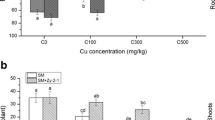Abstract
The root nodules ofMelilotus alba, a leguminous fodder herb, contain a high amount of indoleacetic acid (IAA). The tryptophan pool present in the nodule might serve as a source for the IAA production. Metabolism of IAA in the nodules was evidenced by the presence of IAA-metabolizing enzymes, IAA oxidase and peroxidase. A high amount of IAA was produced by the symbiont isolated from the nodules in culture, when supplemented with tryptophan. For IAA production, the bacteria preferred thel-isomer over thedl- ord-isomer of tryptophan. The possible role of nodular IAA production on the legume-Rhizobium symbiosis is discussed.
Similar content being viewed by others
References
Ambasta S.P.:The Useful Plants of India, p. 362. Council of Scientific and Industrial Research, New Delhi (India) 1986.
Badenoch-Jones J., Rolfe B.G., Letham D.S.: Phytohormones,Rhizobium mutants, and nodulation in lugumes. III. Auxin metabolism in effective and ineffective pea root nodules.Plant Physiol. 73, 347–352 (1983).
Badenoch-Jones J., Summons R.E., Rolfe B.G., Letham D.S.: Phytohormones,Rhizobium mutants, and nodulation in legumes. IV. Auxin metabolism in pea root nodules.J. Plant Growth Regul. 3, 23–39 (1984).
Bray H.G., Thorpe W.V.: Analysis of phenolic compounds of interest in metabolism, pp. 27–52 inMethods of Biochemical Analysis (D. Glick, Ed.). Interscience Publication, New York 1954.
Conn H.J., Jennison M.W., Weeks D.B.: Routine test for the identification of bacteria, pp. 140–168 inManual of Microbiological Methods (H.J. Conn, Ed.). McGraw-Hill Book Co., New York 1957.
Datta C., Basu P.S.: Content of indole acetic acid and its metabolism in root nodules ofCajanus cajan (L.)Millsp.Plant Physiol. Biochem. 24, 71–74 (1997).
De P.S., Basu P.S.: Content of hormones and indole acetic acid metabolism in root nodules ofTephrosia purpurea Pers.Indian J. Plant Physiol. 38, 228–232 (1995).
Dullaart J.: Quantitative estimation of indole acetic acid in root nodules and roots ofLupinus luteus L..Acta Bot. Neerl. 16, 222–230 (1967).
Dullaart J.: The auxin content of root nodules and roots ofAlnus glutinosa (L.)Vill.J. Exp. Bot. 21, 975–984 (1970).
Gordon S.A., Weber R.P.: Colorimetric estimation of indole acetic acid.Plant Physiol. 26, 192–195 (1951).
Hassan S.S.M.: Spectrophotometric method for simultaneous determination of tryptophan and tyrosine.Anal. Chem. 47, 1429–1432 (1975).
Hunter W.J.: Indole-3-acetic acid production by bacteroids from soybean root nodules.Physiol. Plant. 76, 31–36 (1989).
Jordan D.C.:Rhizobiaceae, pp. 235–240 inBergey's Manual of Systematic Bacteriology (N.R. Kried, J.G. Holt, Eds). Williams and Wilkins Co., Baltimore (USA) 1984.
Kar M., Mishra D.: Catalase, peroxidase and polyphenol oxidase activities during rice leaf senescence.Plant Physiol. 57, 315–319 (1976).
Kefford N.P., Brockwell J., Zwar J.A.: The systematic synthesis of auxin by legumes and nodule bacteria and its role in nodule development.Austral. J. Biol. Sci. 13, 456–467 (1960).
Kokkinakis D.M., Brooks J.L.: Hydrogen peroxide mediated oxidation of indole-3-acetic acid by tomato peroxidase and molecular oxygen.Plant Physiol. 64, 220–223 (1979).
Nitsch J.P.: Free auxin and free tryptophan in strawberry.Plant Physiol. 30, 33–39 (1955).
Nutman P.S.: Study frame works for symbiotic nitrogen fixation, pp. 443–447 inRecent Developments in Nitrogen Fixation (W. Newton, J.R. Postgate, C. Rodriguez-Barrueco, Eds). Academic Press, London 1977.
Panse V.G., Sukhatme P.V.:Statistical Methods for Agricultural Workers, 4th ed., pp. 145–156. Indian Council of Agricultural Research, New Delhi (India) 1985.
Sinha B.K., Basu P.S.: Indole-3-acetic acid and its metabolism in root nodules ofPongamia pinnata (L.)Pierre.Biochem. Physiol. Pflanzen 176, 218–227 (1981).
Skerman V.B.D.:A Guide to Identification of Genera of Bacteria, pp. 189–191. Williams and Wilkins Co., Baltimore 1959.
Stafford H.A.: The metabolism of aromatic compounds.Ann. Rev. Plant Physiol. 25, 459–486 (1974).
Vance C.P.: Comparative aspects of root and nodule secondary metabolism.Phytochemistry 17, 1889–1891 (1978).
Wheeler C.T., Henson I.E., Mc Laughlin M.E.: Hormones in plants bearing actinomycete nodules.Bot. Gaz. 140 (Suppl.) S52-S57 (1979).
Williams M.N.V., Singer E.R.: Metabolism of tryptophan and tryptophan analogs byRhizobium meliloti.Plant Physiol. 92, 1009–1013 (1990).
Author information
Authors and Affiliations
Rights and permissions
About this article
Cite this article
Datta, C., Basu, P.S. Content of indoleacetic acid and its metabolism in root nodules ofMelilotus alba . Folia Microbiol 43, 427–430 (1998). https://doi.org/10.1007/BF02818586
Received:
Revised:
Issue Date:
DOI: https://doi.org/10.1007/BF02818586




